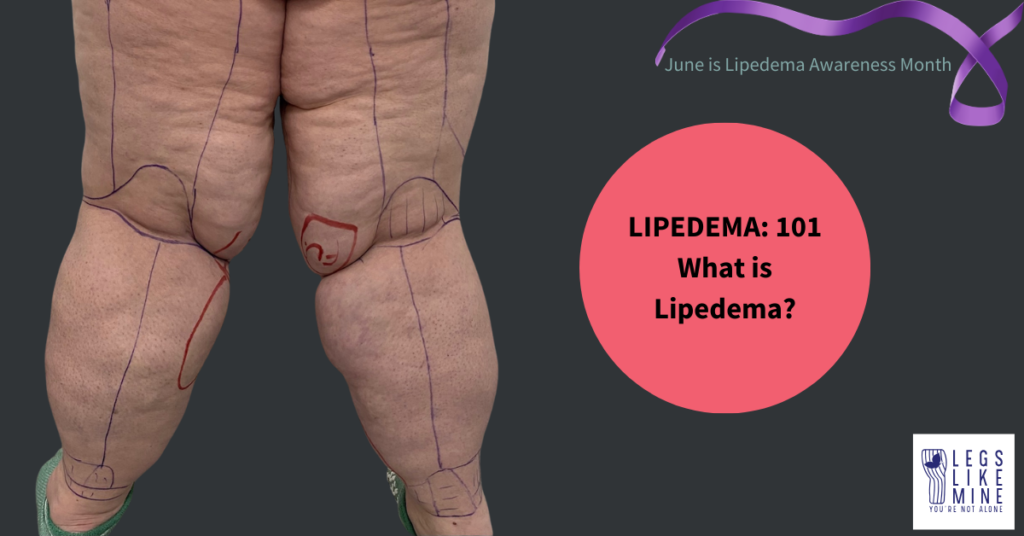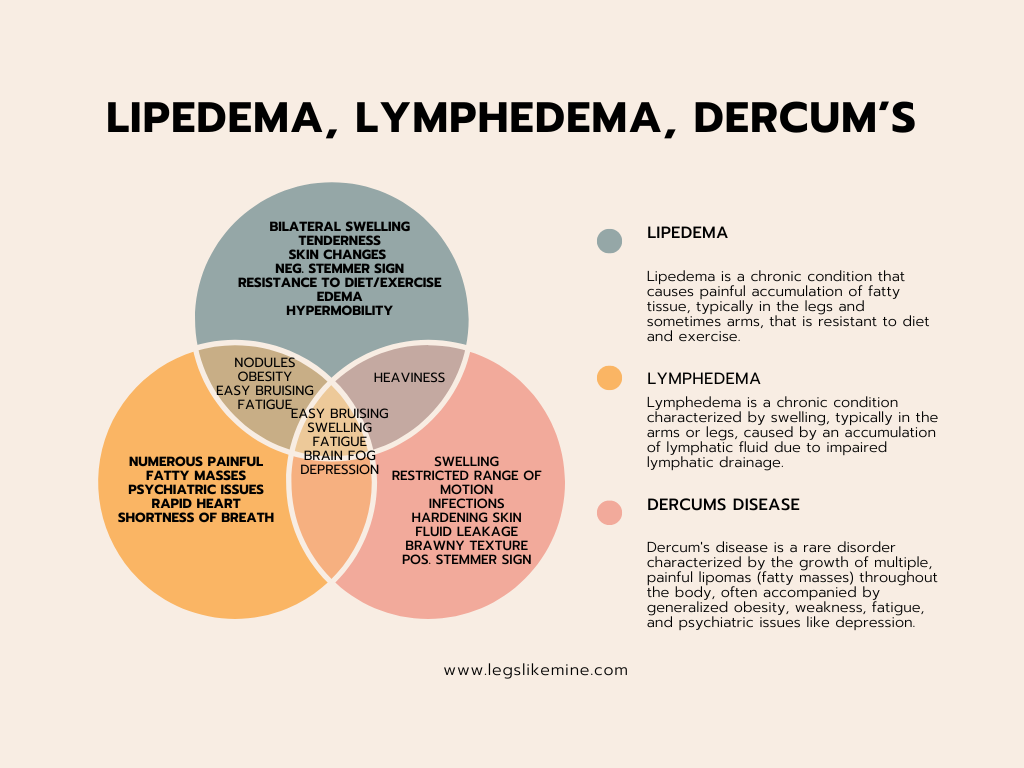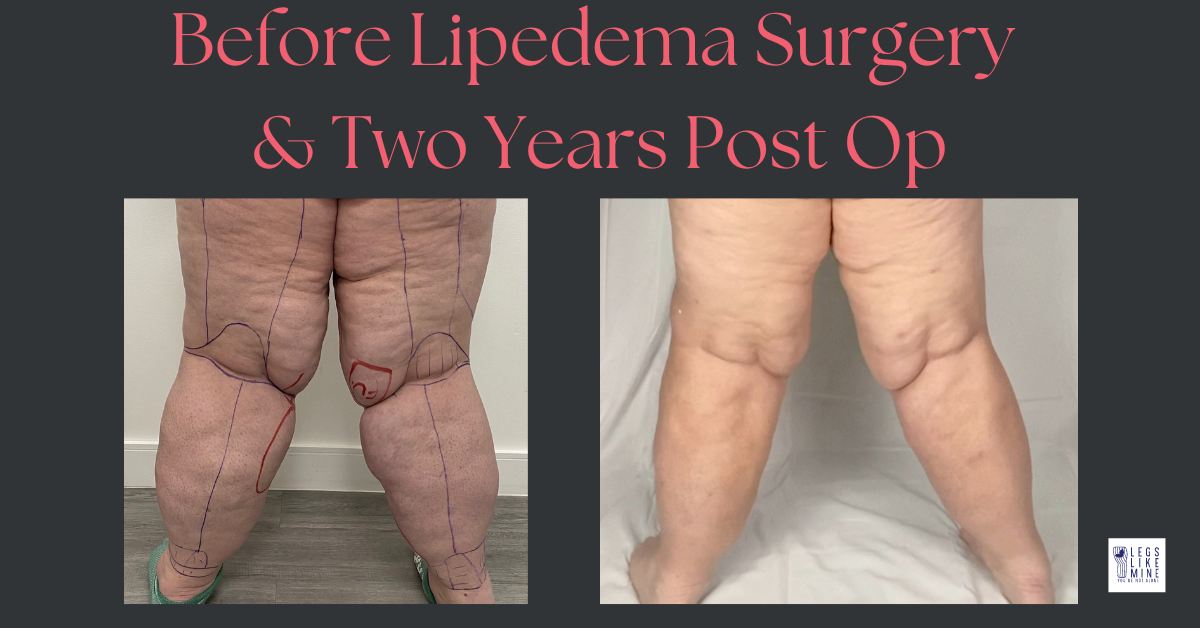Hi friends,
I’ve noticed that a lot of people get these three diseases confused because they are so interrelated. I thought I’d do a post talking about their similarities and differences that we can refer to when FAQs come up. Take me, for example. I have stage III lipedema, which also involves lymphedema having developed. And when I went into the research area at the Fat Disorders Resource Society, the doctor looking at me was feeling around on my lipomas on my arms and back, and said, “I’m about to diagnose you with Dercum’s, but…no.” (That was scary – I hear Dercum’s is incredibly painful. A diagnosis doesn’t make pain happen, but I know I’d be thinking about it.) Anyway…
Lipedema, lymphedema, and Dercum’s disease are three distinct conditions that can cause swelling and abnormal fat distribution in the body. While they share some similarities, it’s crucial to understand their differences to ensure proper diagnosis and treatment. In this blog post, we’ll delve into the key characteristics of each condition, drawing from reputable sources. Let’s just start with, It’s Complicated.
Lipedema
Lipedema is a chronic, progressive condition that primarily affects women. It is characterized by the abnormal accumulation of subcutaneous fat in the legs, thighs, and sometimes arms, resulting in a disproportionate appearance. The fat deposits in lipedema are often painful and tender to the touch, and the condition is frequently misdiagnosed as obesity or lymphedema.
One of the hallmarks of lipedema is that it typically spares the hands and feet, at least in the early stages. The swelling is usually symmetrical, meaning both legs are affected equally. Lipedema is believed to have a genetic component and is often triggered by hormonal changes, such as puberty, pregnancy, or menopause.
Lymphedema
Lymphedema, on the other hand, is a condition caused by a dysfunction or damage to the lymphatic system, which is responsible for draining excess fluid from the body. This can lead to swelling, typically in the arms or legs, as the lymphatic fluid accumulates in the affected area.
Unlike lipedema, lymphedema can affect both men and women, and the swelling is often asymmetrical, meaning one limb may be more affected than the other. The swelling in lymphedema can cause the skin to become thickened and hardened, and it may also increase the risk of infections and other complications.

These are my legs the moment before my first surgery. I have stage III lipedema, which also involves lymphedema.
Dercum’s Disease
Dercum’s disease, also known as adiposis dolorosa, is a rare condition characterized by the growth of painful lipomas (fatty lumps) primarily on the trunk, upper arms, and upper legs. These lipomas can occur just under the skin or deep within the muscles, tendons, ligaments, or even bones.
Patients with Dercum’s disease often experience significant pain and discomfort, and the condition can be debilitating in severe cases. While the exact cause of Dercum’s disease is unknown, it is believed to have an autoimmune component and may be associated with other conditions such as obesity, diabetes, and thyroid disorders.
Treatment and Management
The treatment and management of these conditions vary depending on the specific diagnosis. For lipedema, treatment may involve compression garments, manual lymphatic drainage, and in some cases, liposuction or other surgical interventions. Lymphedema is typically managed through compression therapy, manual lymphatic drainage, and exercise, among other approaches. Dercum’s disease is often treated with pain management strategies, compression garments, and in some cases, liposuction or surgical removal of the lipomas.
It’s important to note that while these conditions share some similarities, they are distinct and require different approaches to diagnosis and treatment. If you suspect you may be experiencing symptoms of any of these conditions, it’s crucial to consult with a healthcare professional who specializes in these areas for proper evaluation and guidance.
As usual, I hope this post is helpful for you and provides enough resources so you can continue to research on your own. Also, as always, talk with your doctor. Be well, friends!
Susan
Resources for You:
https://www.ncbi.nlm.nih.gov/pmc/articles/PMC10688775/
https://www.lipedema.net/lipedema-standard-of-care-guidelines.html
https://www.lipedema.org
https://www.lipedema.net/lipedema-surgery-and-insurance-coverage.html











